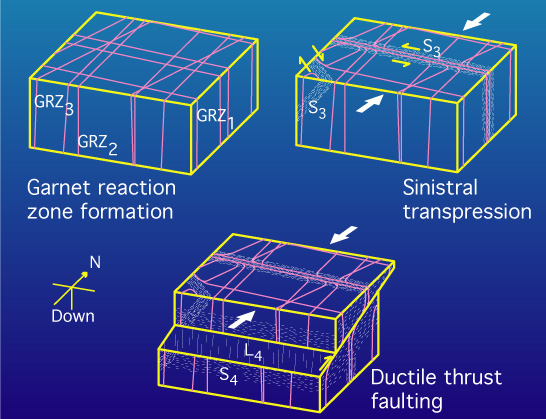Publications
° Daczko, N.R., Klepeis, K.A. and Clarke, G.L. 2001. Evidence of Early Cretaceous collisional-style orogenesis
in northern Fiordland, New Zealand and its effects on the evolution of
the lower crust. Journal of Structural Geology, 23, 693-713.
Abstract
Structural, metamorphic, and kinematic data from a well exposed section
of lower crustal rocks in northern Fiordland, New Zealand reveal a history
of intense contractional deformation and high-P metamorphism at the
roots of an early Cretaceous magmatic arc. High-P (>14 kbars)
granulite facies garnet-clinopyroxene-bearing reaction zones occur adjacent
to anorthositic veins within gabbroic and dioritic gneiss. These veins and
reaction zones were variably deformed by two phases of transitional granulite
facies deformation. Quantitative kinematic analyses, conducted using systems
of rotated veins and reaction zones, indicate that the first phase produced
steeply dipping shear zones within a pure shear-dominated sinistral transpressional
flow regime (Wk=0.69). This deformation occurred at conditions
of P=14.0 ±1.3 kbars and T=676 ±34°C
and resulted in subhorizontal, arc-parallel (NE-SW) stretching and up to
60% subhorizontal shortening of the lower crust at depths >45 km. The second
phase of deformation occurred at P=14.1 ±1.2 kbars and
T=674 ±36°C and produced vertically stacked,
gently-dipping ductile thrust faults that accommodated arc-normal (NW-directed)
displacement. These features reflect major tectonic thickening of the crust,
oblique convergence, and high-P metamorphism during the collision of
an early Cretaceous magmatic arc, represented by plutons of the Median Tectonic
Zone in eastern Fiordland, with the paleoPacific margin of Gondwana, represented
by western Fiordland. Distinctive kinematic styles suggest that this collision
resulted in a partitioning of the arc-parallel (NE-SW) and arc-normal (NW-SE)
components of oblique convergence onto sinistral strike-slip and ductile
thrust faults, respectively, at lower crustal levels.

|
 ARC Centre of Excellence for Core to Crust Fluid Systems
ARC Centre of Excellence for Core to Crust Fluid Systems